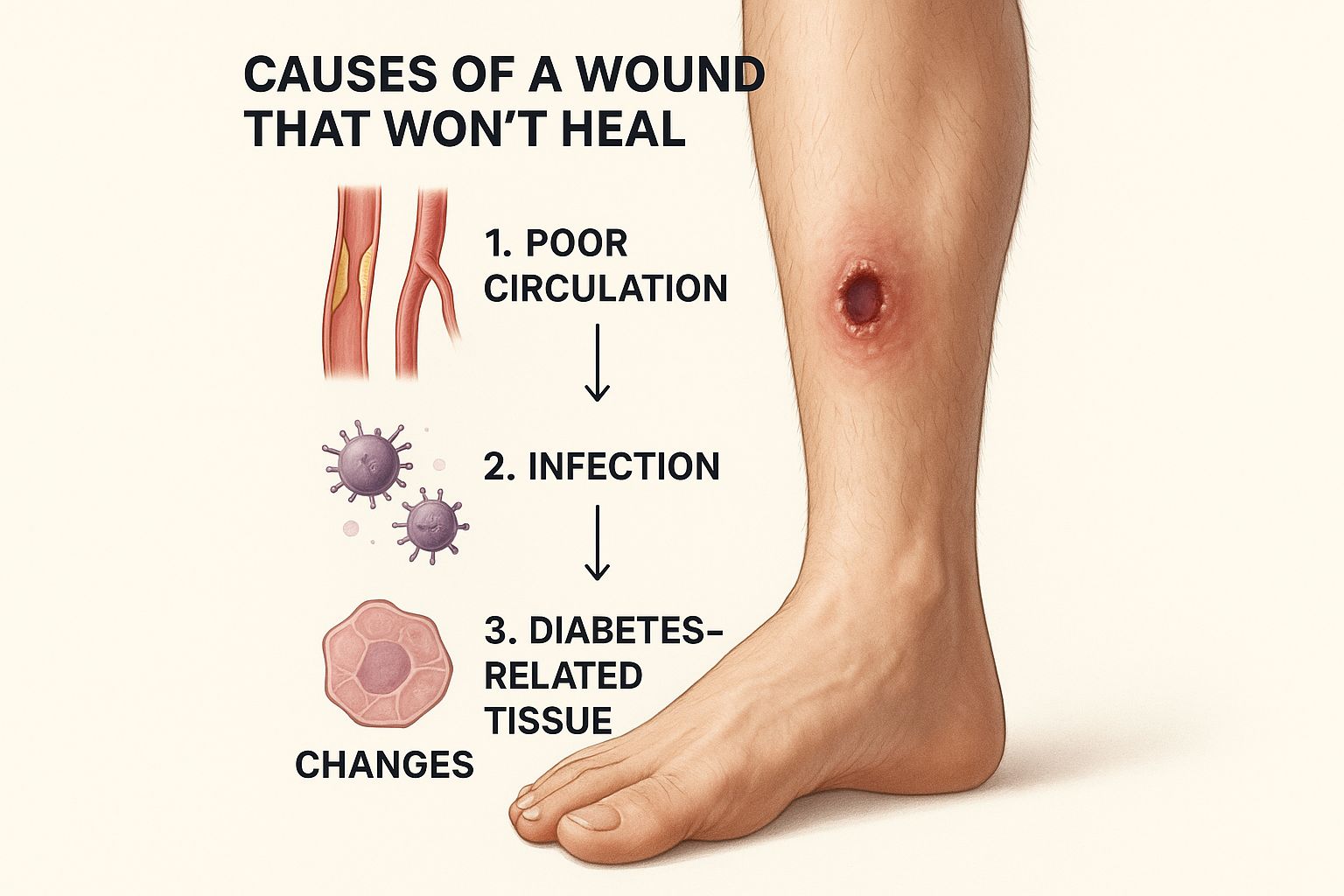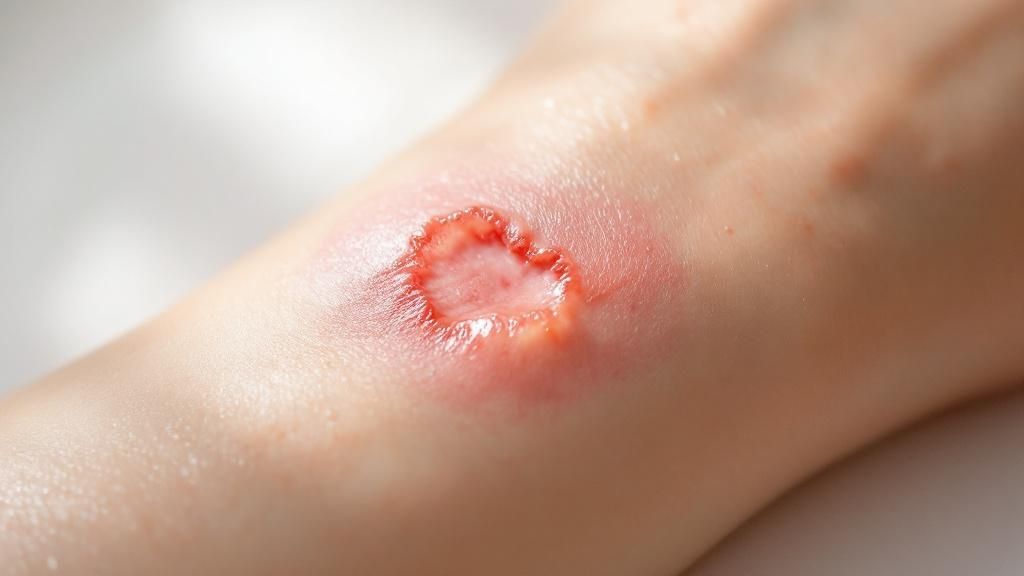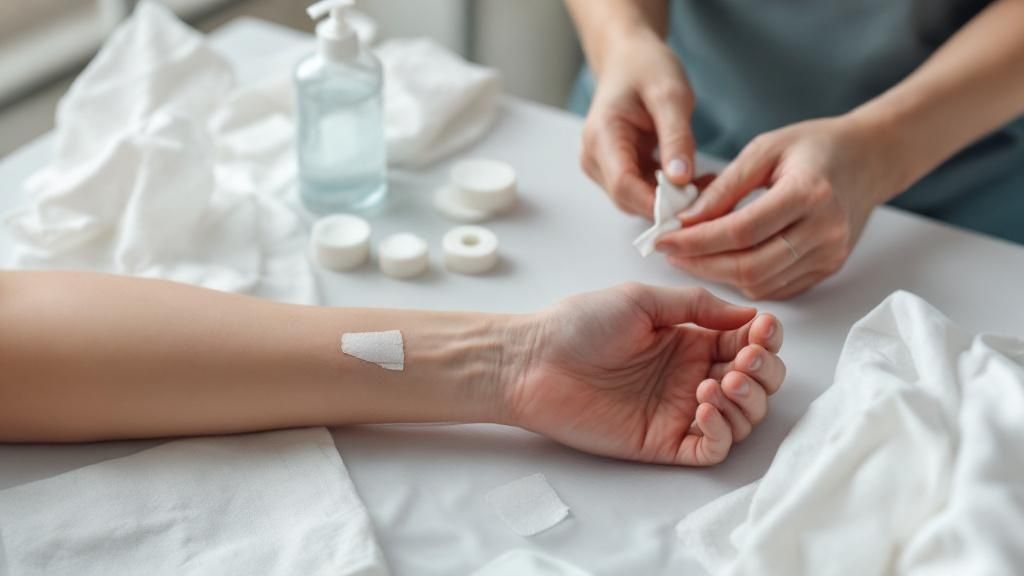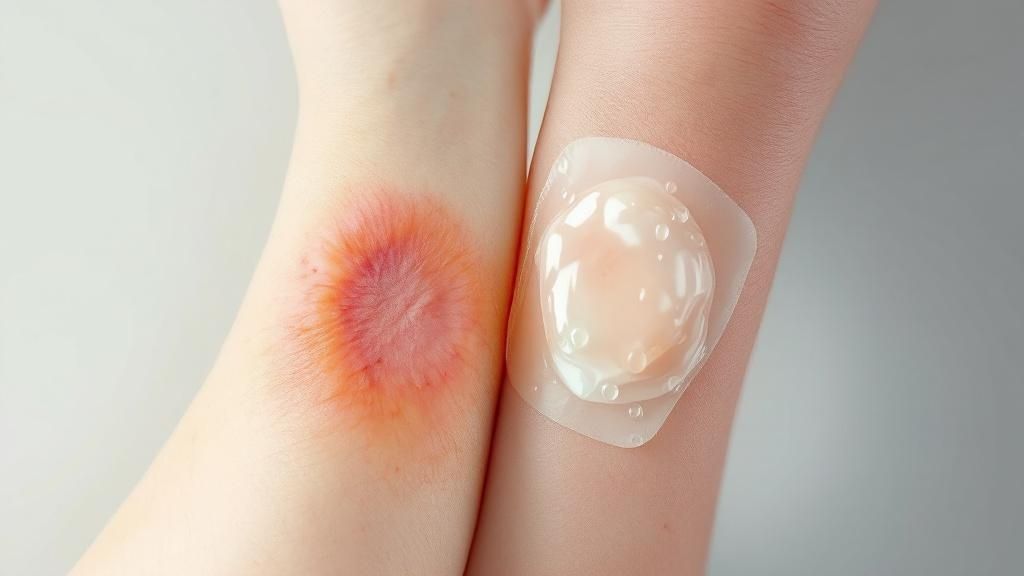When you're dealing with a cut or sore that just won't go away, it's more than just frustrating—it's genuinely concerning. Having a wound not healing is a constant, nagging worry that can throw your daily life off-balance. If this sounds familiar, know that you’re definitely not alone in this struggle.
Why a Stubborn Wound Is a Bigger Deal Than You Think
Watching that same wound linger, day after day, can feel incredibly isolating. But the problem of a wound that fails to heal properly is far more than a simple inconvenience. It's a sign that one of your body’s most essential functions—its ability to repair itself—has hit a roadblock. This guide is built to address the real-world questions and anxieties people face when healing goes wrong.
We're going to move past the generic advice. Instead, we'll give you a clear, practical look at how your body is supposed to heal. You'll learn the normal stages of recovery, uncover some of the surprising reasons your progress might be stalled, and get actionable home-care tips that can make a real difference.
The impact of chronic wounds is staggering, both physically and emotionally. In the United States alone, chronic ulcers cost the healthcare system an estimated $28 billion annually when they are the primary diagnosis. You can discover more about the widespread impact of non-healing wounds and their associated costs.
What You Will Learn
Our goal is to replace that feeling of anxiety with actionable knowledge and confidence. We’ll walk through everything you need to know, step-by-step.
Here's what we'll cover:
- The Four Stages of Normal Healing: Think of this as the blueprint your body follows to repair damage. We'll break it down so you know what should be happening.
- Common Roadblocks to Recovery: We'll pinpoint the specific culprits—from hidden infections to simple nutritional gaps—that could be stopping your wound in its tracks.
- Effective At-Home Strategies: Learn practical ways to create the ideal environment for your wound to finally start healing.
- Critical Red Flags: Get to know the clear signs that tell you it's time to stop waiting and see a specialist about your wound not healing.
- Advanced Treatment Options: Explore the modern therapies that are giving new hope for even the most stubborn and persistent wounds.
By the end, you'll feel empowered with the information you need to take control of your healing journey and find a clear path forward.
How Your Body's Healing Process Works
Before we can figure out why a wound isn't healing, we first need to appreciate how the body is supposed to heal. When you get a cut or scrape, your body doesn't just randomly patch it up; it launches a highly coordinated, multi-stage repair mission.
Think of it like a specialized construction crew showing up to a damaged building. Each team has a specific job, a specific timeline, and they have to work in the right order. When you're dealing with a wound not healing, it's usually because one of these crucial teams has been delayed, disrupted, or isn't getting the resources it needs.
Let's walk through the four phases of this incredible natural process. Understanding this sequence is the key to spotting where things might have gone wrong.
Phase 1: Hemostasis – The Emergency Stop
The second your skin is broken, the first priority is damage control. This initial response is called hemostasis, which is just a technical term for "stopping the bleed."
Imagine a pipe bursts in your house. The very first thing you do is rush to shut off the water main. Your body does something similar. The blood vessels around the injury immediately constrict to limit blood flow. At the same time, tiny cells called platelets flood the area, get sticky, and start clumping together to form a quick, temporary plug.
Finally, proteins in the blood are activated to create a tough, fibrous mesh called fibrin. This mesh reinforces the platelet plug, turning it into a solid, stable clot. This not only prevents further blood loss but also creates the foundational structure for the real repair work to begin. It’s a rapid-fire response that takes just a few minutes.
Phase 2: Inflammation – The Cleanup Crew
With the "leak" plugged, the cleanup crew arrives. This is the inflammation phase, and while the word itself often sounds negative, this step is absolutely essential for proper healing. It typically lasts for a few days.
During this stage, specialized white blood cells are sent to the wound to act as security and sanitation. They hunt down and destroy any invading bacteria and clear out all the dead cells and debris left over from the injury. The tell-tale signs of this phase are what we all recognize: redness, warmth, swelling, and some tenderness. That's just your immune system hard at work, making the site clean and safe for rebuilding.
This is often where problems first arise. As the infographic shows, many underlying health issues can stall this process right out of the gate.

When things like poor circulation, infection, or diabetes get in the way, the body’s repair system simply can't function as it should.
Phase 3: Proliferation – The Rebuilding Stage
Once the site is clean and secure, the heavy construction can begin. This is the proliferation, or rebuilding, phase. It’s an intensive process that can last for several weeks, with the main goal of filling the gap and covering it with new skin.
A few amazing things happen all at once here:
- New Tissue Fills the Wound: A fresh, bumpy, bright red tissue called granulation tissue starts building up from the base of the wound. It's packed with new blood vessels that deliver the oxygen and nutrients needed for the project.
- Collagen Provides Strength: Cells called fibroblasts arrive and start producing collagen, a strong protein that acts like the mortar between bricks, giving the new tissue structure and durability.
- The Wound Shrinks: The edges of the wound are gradually pulled inward, making the area that needs to be filled smaller and smaller.
This rebuilding phase is where dedicated wound care truly shines. Creating the perfect environment for these cells to do their work can make all the difference in your final outcome. We cover this in more detail in our guide on how home wound care speeds up recovery.
Phase 4: Maturation – The Final Reinforcement
The last stage of the job is maturation, sometimes called remodeling. This is by far the longest phase, often lasting for a year or even longer. Here, the focus shifts from building to strengthening.
The collagen that was laid down quickly in the previous phase is now carefully reorganized and restructured, making it much stronger and more resilient. This process increases the tensile strength of the new skin, making it less fragile. Over time, the scar tissue will flatten and fade.
It's important to know that this new patch of skin will never be quite as strong as the original, typically reaching about 80% of its initial strength at best. But this final phase ensures it’s as tough and durable as it can possibly be. When a wound gets "stuck" in an earlier phase, it never gets to this vital strengthening step.
To help you visualize this entire journey, here is a quick summary of the normal healing timeline.
The Four Stages of Wound Healing
This table breaks down the purpose and typical duration of each phase in the body's natural repair process.
| Healing Phase | Primary Goal | Key Cellular Activity | Typical Duration |
|---|---|---|---|
| Hemostasis | Stop bleeding | Platelets activate, fibrin mesh forms a clot. | Minutes to hours |
| Inflammation | Clean the wound site | White blood cells remove bacteria and debris. | 1-5 days |
| Proliferation | Rebuild new tissue | Granulation, collagen deposit, wound contraction. | 3-21 days |
| Maturation | Strengthen the repair | Collagen reorganizes to increase tensile strength. | 21 days to 1-2 years |
Understanding this natural cascade makes it much easier to see how a chronic wound is essentially a healing process that has been arrested, unable to move on to the next critical stage.
Uncovering Why Your Wound Healing Is Stalled

When a wound just won't heal, it's more than just bad luck. It's a clear signal that something is actively disrupting your body's amazing repair process. A wound not healing for weeks or months almost always points to a specific roadblock. These issues generally fall into two buckets: problems happening right at the wound site (local factors) and broader health issues affecting your entire body (systemic factors).
Think of healing like a construction project. Local factors are like problems on the job site—bad weather or faulty equipment. Systemic factors are like a city-wide supply chain breakdown. Let's dig into what might be throwing a wrench in the works.
Local Factors: Problems at the Wound Site
Local factors are issues confined to the immediate wound area. They directly interfere with the cellular crews trying to rebuild the damaged tissue.
Here are the most common culprits we see:
- Poor Blood Flow (Ischemia): Your blood is the delivery service for oxygen and nutrients—the fuel your healing cells need. If circulation is weak, the repair crew is essentially starved of its supplies. This is a huge factor in lower leg wounds and diabetic foot ulcers.
- Repetitive Pressure: Constant pressure on a wound, especially from sitting or lying in one position, literally squashes the tiny blood vessels. This cuts off the supply line and can crush the fragile new tissue trying to form.
- Hidden Infection: A bacterial infection is like having vandals on a construction site. They create chaos, release toxins that kill healthy cells, and trigger a relentless inflammatory response that keeps the rebuilding phase from ever starting.
- Wound Edge Problems (Epibole): This is a tricky one. Sometimes, the skin cells at the wound's edge get their signals crossed. Instead of growing across the open area to close it, they curl inward, creating a thickened rim. This builds a physical wall, stopping healing in its tracks.
These local issues can easily create a vicious cycle. For instance, poor blood flow makes a wound more vulnerable to infection, and an active infection can further damage the already compromised blood vessels.
Systemic Issues: How Your Overall Health Gets in the Way
While local factors disrupt the job site, systemic factors are body-wide conditions that undermine the entire healing infrastructure. They weaken your body's ability to mount an effective repair from the get-go.
It's like trying to build a house during a city-wide power outage with a shortage of materials. That’s what it's like for your body to heal when facing a major systemic challenge.
The Role of Underlying Health Conditions
Certain medical conditions are notorious for sabotaging the healing process.
- Diabetes: High blood sugar is a triple threat. It damages nerves (so you might not even feel an injury), harms blood vessels (restricting blood flow), and weakens the immune cells needed to fight infection. This is why a simple cut can quickly become a dangerous, non-healing wound.
- Vascular Disease: Conditions that affect your arteries or veins, like peripheral artery disease (PAD) or venous insufficiency, directly choke off the blood supply. Without good circulation, healing is next to impossible. Many stubborn leg ulcers are tied directly to these issues, and you can learn more about why a leg ulcer might not be healing in our dedicated guide.
- Autoimmune Disorders: In conditions like rheumatoid arthritis or lupus, the body’s immune system can become dysregulated, disrupting the delicate balance needed to move past the initial inflammation phase of healing.
The Impact of Nutrition and Lifestyle
What you eat and how you live directly provide—or fail to provide—the building blocks for repair. A poor diet is like sending your construction crew to work without any bricks or mortar.
Key nutrients for healing include:
- Protein: The absolute foundation for building new tissue.
- Vitamin C: Essential for creating collagen, the "scaffolding" that holds new skin together.
- Zinc: A critical mineral for cell growth and proper immune function.
Smoking is another huge saboteur. The nicotine in cigarettes causes blood vessels to clamp down, drastically cutting oxygen delivery to the wound. Even a single cigarette can impair blood flow for hours, stalling the healing process.
As our population ages and rates of conditions like diabetes and obesity rise, chronic wounds are becoming a more significant healthcare challenge. By understanding both the local and systemic factors at play, you can start to piece together the puzzle of why your wound is stalled and take the first steps toward getting your recovery back on track.
Actionable Home Care to Support Healing
While some of the reasons a wound won't heal need a specialist's touch, the care you provide at home can make a world of difference in your recovery. Think of your body as a dedicated repair crew; your job is to give them the best possible environment to work in.
You have more power here than you might think. By focusing on proper cleaning, creating the right healing environment, and fueling your body from the inside out, you give yourself the best shot at getting back on track. This is your game plan for supporting your body's amazing natural repair systems.
The Right Way to Clean and Dress a Wound
Good wound hygiene is your first line of defense against infection, but a lot of common household "wisdom" can actually cause more harm than good. It’s easy to accidentally damage the fragile new cells your body is trying to build, slowing everything down.
First, let's talk about what to avoid. Stay away from harsh cleansers like hydrogen peroxide and rubbing alcohol. While they certainly kill bacteria, they're also cytotoxic—meaning they kill the healthy fibroblast and keratinocyte cells that are working hard to rebuild your tissue. A gentle touch is what’s needed.
Key Takeaway: The goal isn't to sterilize the wound with harsh chemicals. It’s to gently remove debris and lower the bacterial count without hurting the delicate new tissue trying to grow.
A simple saline solution (salt water) or just mild soap and water is all you need. Gently clean around the wound and pat it dry with a clean cloth. Never scrub aggressively; you can easily disrupt the delicate new tissue that’s trying to fill the wound bed.
The Myth of "Airing It Out"
One of the most stubborn myths in first aid is that a wound needs to "breathe" or air out to heal. The reality is the exact opposite. Decades of research have proven that wounds heal faster, with less scarring and a lower risk of infection, when they are kept moist and covered.
When a wound dries out, it forms a hard scab. This scab is like a roadblock for new skin cells, which need a moist surface to travel across to close the wound.
Here’s what to look for in a proper dressing:
- Maintain Moisture: Choose a dressing that keeps the wound bed moist but can also absorb any excess fluid or drainage.
- Provide Protection: The dressing should act as a physical shield, protecting the vulnerable area from bacteria and accidental bumps.
- Allow for Gas Exchange: Modern dressings are pretty smart; they are designed to let oxygen in while keeping germs and contaminants out, which is crucial for the healing process.
For a closer look at managing more significant injuries, which often demand specific techniques, our article on how to heal deep wounds faster offers some excellent insights.
Fueling Your Recovery from the Inside Out
You can’t build a house without bricks and mortar. In the same way, your body can't build new tissue without the right nutritional building blocks. If your wound has stalled, your diet is one of the first and most powerful places to look for a solution.
A nutrient-rich diet is non-negotiable when a wound is struggling to heal. During the repair process, your body's demand for certain nutrients skyrockets.
Focus on bringing these healing powerhouses to your plate:
- Protein: This is the absolute foundation for tissue repair. Every new cell—whether it's skin, a blood vessel, or an immune cell—is built from protein. Aim for lean meats, fish, eggs, beans, and Greek yogurt.
- Vitamin C: Absolutely essential for creating collagen, the protein that acts like scaffolding for new skin. You'll find it in citrus fruits, bell peppers, broccoli, and strawberries.
- Zinc: This mineral is a workhorse, playing a role in over 300 enzyme functions in the body, including cell growth and immune support. Good sources include nuts, whole grains, and lean red meat.
- Hydration: Water is the delivery truck that brings all these nutrients to the wound site through your bloodstream. Being dehydrated thickens your blood and slows down circulation, effectively starving the very tissues that need help.
Knowing When To See a Wound Care Specialist

Even when you’re doing everything right at home, some wounds just refuse to cooperate. A wound not healing after you've given it proper care is your body’s way of saying it needs professional backup. Knowing when to wave the white flag and call in an expert is one of the most crucial parts of this whole process.
Think of it this way: you can handle a leaky faucet, but for a burst pipe, you call a plumber. It's the same with your body. Certain symptoms are serious red flags that demand the attention of a wound care specialist. Waiting too long can turn a simple problem into a major health crisis.
The Clear Signs You Need to Call a Doctor
Your body is pretty good at telling you when something’s wrong. When a wound is in trouble, it sends out warning signals that are hard to miss. If you spot any of the following, it’s time to pick up the phone.
-
No Progress After Two Weeks: If a wound shows zero signs of shrinking or getting better after 14 days, it has officially entered chronic territory. The healing process has hit a roadblock, and it won't get moving again without help.
-
Signs of a Worsening Infection: A little redness is part of the deal, but a full-blown infection is an emergency. Be on the lookout for thick, yellow or green pus, a foul smell from the wound, or pain and warmth that keep getting worse.
-
Spreading Redness or Streaks: Redness that creeps beyond the wound’s edge is a bad sign. If you see red streaks moving away from the injury, that's a classic signal that the infection is spreading through your system.
When your body is also managing a condition like diabetes, these warning signs are even more urgent. Nerve damage and poor circulation can cause even a tiny cut to escalate fast. That’s why we’ve put together a dedicated guide on treating diabetic foot ulcers to help you understand the specific risks.
Symptoms That Demand Immediate Attention
Some signs are more than just warnings—they’re alarm bells. These symptoms point to severe tissue damage or a body-wide problem that needs a doctor’s eyes on it, right away.
Don't wait if you notice:
- New Numbness: If you suddenly lose feeling or get a "pins-and-needles" sensation around the wound, it could mean nerve damage. This can happen from swelling, infection, or another underlying issue.
- Darkening Skin: Skin around the wound that turns dark blue, purple, or black is a critical sign of tissue death, also known as necrosis. This means the tissue isn't getting the blood and oxygen it needs to survive and requires immediate medical care.
Learning to recognize these red flags puts the power back in your hands. It helps you shift from anxiously waiting to taking decisive action. A wound care specialist has the advanced tools and expertise to figure out exactly why your healing has stalled and build a plan to get you back on the road to recovery.
Advanced Treatments for Non-Healing Wounds
When you've done everything right at home and a wound still refuses to heal, it's easy to lose hope. But this is exactly the point where modern wound care shines. For those truly stubborn wounds, specialized clinics have a whole arsenal of therapies designed to kickstart a healing process that has stalled out.
These aren't just fancy bandages. We're talking about active, powerful interventions that directly address the root cause of the problem, whether it's poor circulation, lingering dead tissue, or a bacterial biofilm that won't quit. Let's walk through some of the most effective options a specialist might bring to the table.
Debridement: Clearing the Way for New Growth
One of the first and most critical steps in treating a chronic wound is debridement. The best way to think of it is like preparing a garden bed. You have to clear out all the old, dead plants and weeds before new seeds can sprout and grow.
That's precisely what debridement does. A specialist carefully removes the necrotic (dead) or infected tissue from the wound. This dead material is a huge roadblock; it feeds bacteria, physically blocks healthy cells from migrating, and stops new, healthy tissue from ever taking hold. By clearing it all away, the wound bed finally has a clean, healthy foundation to start rebuilding.
A specialist has a few ways to do this:
- Sharp Debridement: Using sterile instruments like a scalpel or scissors to physically cut away the non-viable tissue. It’s precise and immediately effective.
- Enzymatic Debridement: Applying prescribed ointments that contain special enzymes to naturally dissolve and break down dead tissue over time.
- Autolytic Debridement: Using modern, moisture-retentive dressings that work with your body’s own fluids and enzymes to gently liquefy the unhealthy tissue.
Negative Pressure Wound Therapy
You may have heard this called a "wound vac," and it's a game-changer. Negative Pressure Wound Therapy (NPWT) uses a controlled vacuum to actively pull a wound closed and promote healing. A special foam dressing is fitted into the wound, covered with a clear adhesive film, and then connected by a tube to a small, portable pump.
This gentle but constant negative pressure is a triple threat to a non-healing wound:
- It pulls drainage and excess fluid out, which dramatically reduces swelling.
- It physically draws the edges of the wound together, helping it contract and get smaller.
- It stimulates blood flow, bringing a fresh supply of oxygen and nutrients right where they're needed most.
- It encourages the growth of that healthy, pink granulation tissue that's the hallmark of a healing wound.
NPWT is an incredible tool for large or complex wounds that are having a hard time filling in on their own.
This kind of innovation is part of a huge global focus on chronic wound care. The market is expected to hit $18,675.3 million by 2025 and keep climbing. Still, things like high treatment costs can sometimes be a barrier for patients. You can read more about trends in the global wound care market to see where the industry is headed.
Hyperbaric Oxygen and Bioactive Materials
For the most resistant wounds—the ones that have failed multiple other treatments—specialists can bring out the heavy hitters. One of the most powerful is Hyperbaric Oxygen Therapy (HBOT). During an HBOT session, you relax and breathe pure oxygen inside a pressurized chamber. This environment allows your blood to absorb far more oxygen than it normally could.
This super-oxygenated blood then travels to the wound, delivering a massive boost of the single most important element for cell repair and fighting infection. It can be a true turning point for wounds caused by radiation damage or severe circulation problems.
Other cutting-edge options are also available:
- Bioactive Dressings: These go beyond just covering a wound. They are advanced materials infused with substances like medical-grade honey, silver, or collagen that actively manage bacteria and provide the building blocks for new tissue.
- Bioengineered Skin Substitutes: For very deep or large-area wounds, like a severe burn or diabetic foot ulcer, specialists can apply a "skin substitute." These are sophisticated grafts, sometimes grown from living cells, that act as a scaffold for your own skin to grow over and close the wound.
The key takeaway is this: if you have a wound not healing, you are not out of options. Modern medicine offers a clear path forward, proving that with the right expertise and technology, even the most challenging wounds can be guided toward a full recovery.
Frequently Asked Questions About Wound Healing
Even after understanding the a-to-z of wound healing, you probably have a few practical questions. That's completely normal. Let's tackle some of the most common concerns we hear from patients every day.
How Can I Tell If My Wound Is Infected or Just Inflamed?
This is a big one, and it’s easy to get them mixed up. Think of inflammation as your body’s first responders—it's a normal, healthy part of the healing process. Right after an injury, you'll see some mild redness, warmth, and swelling. That's a good sign! It means your internal cleanup crew has arrived on the scene.
An infection, on the other hand, is a major red flag. It means harmful bacteria have taken over, and things are heading in the wrong direction.
Here’s how to spot the difference:
- Worsening Symptoms: With normal inflammation, the initial redness and swelling will gradually get better. With an infection, the pain, redness, and swelling will get noticeably worse over time.
- Pus or Odor: A healthy wound might have some clear, thin drainage. An infected wound often produces a thick, yellowish or greenish pus and may have a foul smell.
- Spreading Redness: Look for red streaks radiating out from the wound. This is a tell-tale sign the infection is spreading.
- Systemic Signs: If you start running a fever or just feel generally sick and run-down, your body is likely fighting a significant infection.
If you even think you have an infection, don't wait. It’s time to see a doctor right away.
Should I Let My Wound "Air Out" to Heal Faster?
This is one of the most stubborn myths in wound care, but it actually does more harm than good. The idea of letting a wound "breathe" sounds logical, but science has shown us something completely different: wounds heal best in a moist, clean, and protected environment.
When you let a wound air out, a hard, dry scab forms.
This scab is like a roadblock for your healing cells. It creates a physical barrier that stops new skin cells from moving across the wound and closing it up. A proper dressing is far more effective.
The right kind of bandage keeps the wound bed moist, shields it from bacteria, and creates the ideal conditions for your body to do its repair work efficiently.
Can My Diet Really Make a Difference in How My Wound Heals?
Absolutely—it’s not just a small factor, it’s a critical one. Think of your body as a construction site and your food as the raw materials. Without the right supplies, the project grinds to a halt.
A diet low in protein can seriously slow down the creation of new skin, muscle, and blood vessels. Similarly, you need key vitamins and minerals. Vitamin C is essential for building collagen (the scaffolding of your skin), and Zinc is a powerhouse for new cell growth.
Being dehydrated can also throw a wrench in the works, as every cell in your body needs water to function properly. For a deeper dive into this, check out these tips for effective post-discharge wound care at home.
If you're dealing with a wound that just won't heal and need expert care brought straight to your door, Rapid Wound Care can help. We connect you with specialized treatment at home, taking the stress out of getting the professional care you deserve. Visit RapidWoundCare.com to learn how we bring advanced healing to you.

